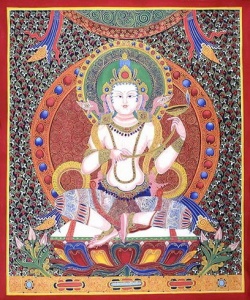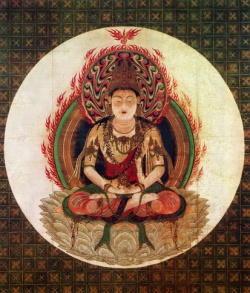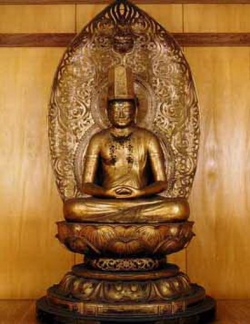Sthaviravāda
Sthaviravāda (Sanskrit: स्थविरवाद; traditional Chinese: 上座部; pinyin: Shàngzuò Bù) literally "Teaching Of The Elders", was one of the early Buddhist schools. It was one of the two main movements in early Buddhism that arose from the Great Schism in pre-sectarian Buddhism, the other being that of the Mahāsāṃghika school.
Origins
Most sources place the origin of the Sthaviras to the Second Buddhist council. Traditions regarding the Second Council are confusing and ambiguous, but it is agreed that the overall result was the first schism in the Saṃgha, between the Sthaviras and the Mahāsāṃghikas, although it is not agreed upon by all what the cause of this split was.
One suggested cause of the Great Schism were the disagreements in the five theories about an Arhat supposedly put forward by Mahādeva, who later founded the Mahāsāṃghika. The monks who rejected the five theories named themselves as "Sthaviravāda" to differentiate from the Mahāsāṃghika.
However, this account relies on a later text, the Mahāvaṃsa. Vasumitra's Samayabhedoparacanacakra, an earlier source whose writing probably dates from around 100 CE, and which is preserved in Chinese and Tibetan, there is no mention of any such person named Mahādeva.
Instead, it lists the names of the well-known figures who accepted or rejected the five theories. Étienne Lamotte has also demonstrated that the existence of the "Mahādeva" character was a later sectarian interpolation.
Andrew Skilton has suggested that the problems of contradictory accounts are solved by the Mahāsāṃghika Śāriputraparipṛcchā, which is the earliest surviving account of the schism.
In this account, the council was convened at Pāṭaliputra over matters of vinaya, and it is explained that the schism resulted from the majority (Mahāsaṃgha) refusing to accept the addition of rules to the Vinaya by the minority (Sthaviras).
The Mahāsāṃghikas therefore saw the Sthaviras as being a breakaway group which was attempting to modify the original Vinaya.
Scholars have generally agreed that the matter of dispute was indeed a matter of vinaya, and have noted that the account of the Mahāsāṃghikas is bolstered by the vinaya texts themselves, as vinayas associated with the Sthaviras do contain more rules than those of the Mahāsāṃghika Vinaya.
Modern scholarship therefore generally agrees that the Mahāsāṃghika Vinaya is the oldest. According to Skilton, future scholars may determine that a study of the Mahāsāṃghika school will contribute to a better understanding of the early Dharma-Vinaya than the Theravāda school.
The Tibetan historian Buton Rinchen Drub wrote that the Mahāsāṃghikas used Prākrit, the Sarvāstivādins used Sanskrit, the Sthaviravāda used Paiśācī, and the Saṃmatīya used Apabhraṃśa.
Legacy
The Sthaviras later divided into other schools such as the Sarvāstivāda school and the Vibhajjavāda (Sanskrit: Vibhajyavāda) school. The resultant Vibhajjavāda branch gave rise to a number of schools such as the Tāmraparnīya (later called Theravada), the Dharmaguptaka school, the Mahīśāsaka school, and the Kāśyapīya school.
Relationship to Theravāda
The Theravāda school of Sri Lanka and Southeast Asia has identified itself exclusively with the Sthaviravāda, as the Pali word thera is equivalent to the Sanskrit sthavira. This has led early Western historians to assume that the two parties are identical.
However, this is not the case, and by the time of Ashoka, the Sthaviravāda school had split into the Sammitīya, Sarvāstivāda, and the Vibhajyavāda schools.
The Vibhajyavāda school is believed to have split into other schools as well, such as the Mahīśāsaka school and the ancestor of the Theravāda school. According to Damien Keown, there is no historical evidence that the Theravāda school arose until around two centuries after the Great Schism which occurred at the Third Council.
The Dīpavaṃsa, a Theravādin source, identifies Theravāda with Sthaviravāda, and compares other early Buddhist schools to thorns on a banyan tree.
These 17 sects are schismatic,
only one is non-schismatic.
With the non-schismatic sect,
there are eighteen in all.
Like a great banyan tree,
the Theravāda is supreme,
The Dispensation of the Conqueror,
complete, without lack or excess.
The other sects arose
like thorns on the tree.
— Dīpavaṃsa, 4.90–91
Theravādin accounts
According to the Mahāvaṃsa, a Theravādin source, after the Second Council was closed those taking the side of junior monks did not accept the verdict but held an assembly of their own attended by ten thousand calling it a Mahasangiti (Great Convocation) from which the school derived its name Mahāsāṃghika.
However, such popular explanations of Sthaviravāda and Mahāsāṃghika are generally considered folk etymologies. The Theravādin Dīpavaṃsa clarifies that the name Theravāda refers to the "old" teachings, making no indication that it refers to the Second Council. Similarly, the name Mahāsāṃghika is in reference to those who follow the original Vinaya of the undivided Saṃgha.


